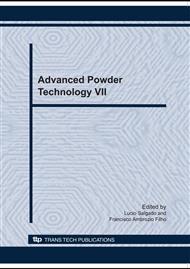p.525
p.531
p.537
p.543
p.549
p.555
p.561
p.567
p.573
Film Fraction and Droplet Size inside of a Rectangular Venturi Scrubber
Abstract:
The Venturi scrubber, equipment frequently used in the removal of particles from gases, is constituted basically by a duct with a convergent section followed by a constriction, or throat, and a divergent section. A liquid, usually injected in the throat, is atomized by the flowing air at high speed. The formed droplets act as collectors of particles from the gas. The process of droplet formation from an injected liquid can be described as follows: the liquid enters the gas stream in the form of a jet, perpendicular to the gas flow. As the jet penetrates the gas stream, it is bent by the gas drag. After a given penetration distance, a burst occurs, and the remaining jet is disintegrated as a droplet cloud. Depending on the liquid and gas flow rates, the penetration on the jet into the gas stream may reach the walls of the equipment, and a fraction of liquid deposits in the form of a film. This film contributes little for the removal of particles from the dust laden gas. Few studies have analyzed the formation of film at the scrubber walls and its influence in the droplet size inside the Venturi scrubber. For this reason, the present study is focused on the experimental measurement of the deposition of the liquid film on the walls of a rectangular Venturi scrubber and, simultaneously, the estimation of the droplet size measured in the Venturi throat. The experiments were carried out varying the liquid flow rate, the gas velocity and the number of orifices of liquid injection. A correlation, using a dimensionless number, was proposed to quantify the influence of each experimental condition. The results indicate that film fraction has a significant influence in the droplet size measured inside of Venturi scrubber.
Info:
Periodical:
Pages:
549-554
Citation:
Online since:
October 2010
Keywords:
Price:
Сopyright:
© 2010 Trans Tech Publications Ltd. All Rights Reserved
Share:
Citation:


